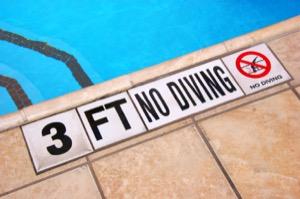Your Family
Swimming Pool Accidents

Swimming Pool Accidents are governed by the general principles of negligence and premises liability previously set forth and the damages are governed by the personal injury damages section on this site.
Severe injury or death can occur when swimming pools are used carelessly or without proper supervision. Slides and diving boards can be dangerous if installed or allowed to be used improperly. The most common type of claims that arise in swimming pool accidents involves drowning or brain damage due to oxygen deprivation. Catastrophic injury can also occur when someone dives or is thrown into a pool where the water is too shallow. The owner or management company responsible for the supervision of the pool would be responsible for proper supervision of the pool area including the posting of signs indicating the correct depth of pool water. Another type of injury can involve the filter system and drainage system of the pool. Children have been disemboweled in swimming pools when the filter system is set too strong and the child gets near the intake valve and gets caught in the intake valve.
Any time a person is injured or dies as a result of a swimming pool accident it is important for the swimming pool accident attorney to investigate many theories of liability. The training and supervision of lifeguards is often questionable. The rotation of lifeguards in shifts can be important. The mechanical functioning of pool equipment can be problematical. Wading pools can be particularly dangerous because they can often be unprotected. Moreover, many cases involve drains with strong backflow to the filter system and thereby suck a young, weak child to the drain causing drowning or organs to be sucked out of a child’s body. Proper signage around pool areas, particularly where it could be expected that swimmers may dive into shallow areas, can cause liability problems. Fencing, lighting, locks on gates, height of fencing are all areas of possible inquiry. In any event, an experienced swimming pool accident lawyer must be able to develop all appropriate theories of liability to allow you to prevail.
Drowning deaths continue to remain a large problem. In 2005, there were 3,582 fatal unintentional drownings in the United States, averaging 10 deaths per day. Statistics show that more than one in four fatal drowning victims is under the age of 14. More importantly, nonfatal drownings can cause brain damage that may result in long-term disabilities.
Males, children, and minorities are most at risk of drowning. In 2005, males were four times more likely to die from unintentional drowning than females. Fatal drowning remains the second-leading cause of unintentional injury-related death for children under the age of 14. In 2005, 30% of all children under the age of four died of drowning. African American children also have a higher fatal unintentional drowning rate.
Major risk factors of drowning deaths include: lack of barriers and supervision; age and recreation in natural water settings; lack of appropriate choices in recreational boating; alcohol use; and seizure disorders. Children under the age of one most often drown in bathtubs, buckets, or toilets. Children between the ages of one and four are reported to have higher statistics of drowning in residential swimming pools. Sadly, most young children who drowned in pools had only been out of sight for less than five minutes. Most drownings of children over the age of 15 occur in natural water settings. Boating fatalities caused by drowning are usually the result of not wearing a life jacket. Alcohol remains a high risk factor in both adolescent and adult drowning deaths. Furthermore, swimming and alcohol should not be mixed as alcohol influences balance, coordination, and judgment which are all affected by sun exposure and heat. Finally, drowning is the most common cause of unintentional injury death for people with seizure disorders.
There are ways to help prevent drownings from occurring. First, strict supervision of children playing in or around water is absolutely crucial. Swimming alone should also be avoided and lifeguard supervision is a fundamental feature of swimming safety. Alcohol and swimming should never be combined. Young children should also be prepared with swimming lessons. However, these swimming lessons should never mistake the need for adult supervision. Knowledge and use of CPR has been shown to improve outcomes in drowning victims, which allows for immediate relief until paramedics arrive. Finally, air-filled or foam toys should not be used in place of life jackets. For those families with pools at home, installation of a fence is necessary to help prevent drowning deaths from occurring. Also, floats and toys should be removed from the pool so as not to encourage young kids to get into the pool. Weather awareness, use of life jackets, and rip current identification are important ways to help prevent drowning in or around natural bodies of water.
The legal information on this site is not intended to be legal advice. Contact one of our experienced swimming pool accident attorneys or lawyers today to get specific information and answers for your specific situation.










